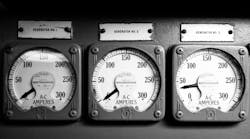After recovering from years of economic turmoil, the market for power electronics that switch, convert, and manage electric current relapsed in 2015, according to new estimates from two research firms. Power modules and discrete semiconductors were hit hardest, but growing sales of integrated circuits helped cover some of the losses.
Sales of power electronics were around $34 billion last year, down 2.6% from 2014, according to technology research firm IHS Markit. In a separate analysis, research firm Yole Développement estimated that sales of power electronics declined around 3% in 2015.
A major reason for the downturn was underwhelming sales of high-voltage devices, said Jonathon Liao, an analyst with IHS Markit, in an interview. These devices, which handle voltages above 600 volts, are used in applications including industrial generators, motor controls, trains, and the electric grid. The companies that usually invest in these applications were buying fewer power devices in 2015, Liao said.
Economic growth in many countries, including the United States and China, has been slowing. The result is that companies and government agencies are not spending as much on costly power modules and bulk orders of discrete power semiconductors, Liao said. Sales of discrete power semiconductors, like MOSFETs and rectifier diodes, fell 10.1% in 2015, while the power module market declined 11.4%.
Other applications for power electronics – like inverters for solar energy, power supplies in data centers, and motor controls for electric cars – are not yet taking up the slack. But there are few doubts that the market will improve over the next five years, especially with the rise of electric vehicles. Liao estimated it would only be a year before modules hit their stride. Analysts for Yole Développement said that power modules will reach an annual growth rate of 10.3% in 2020, while shipments of discrete components will experience 5.1% growth.
The decline runs counter to the spreading influence of power electronics. The Department of Energy estimates that 80% of all electricity will flow through power devices in 2030. To prepare for that era of circuitization, it has set aside millions in funding to develop wide bandgap semiconductors that handle higher voltages and are more efficient than silicon. Many companies, including GaN Systems and Transphorm, are making transistors out of wide bandgap materials, which can be used in power supplies and power converters inside things like smartphone chargers.
The influence is obvious in the market for power integrated circuits, which grew 4.5% during 2015, according to IHS Markit. These circuits are widely used to manage power consumption in the complex signal processing between sensors, wireless circuits, and microprocessors. Low-end smartphones, smart building devices, and automotive displays were among the largest markets for power circuits over the last year, said Liao.
Power integrated circuits buttress the sensors and wireless connectivity that are changing entire industries. Electric vehicles, for instance, are using power circuits to help manage battery life and the flow of electricity to on-board computers and displays.
These shifts were underlined when last month Analog Devices acquired Linear Technology in a $14.8 billion deal. Peter Real, Analog’s chief technology officer, said in an interview last month that the deal was aimed at supplying chips for both signal processing and ensuring that not too much power is consumed in the process. He said that the deal followed Analog’s strategy of expanding into automotive, industrial, and wireless infrastructure.
The deal was only the latest example of the consolidation among chipmakers, which are seeking new combinations of chips for growth. Some of the largest deals have combined makers of power and other analog semiconductors, which are more costly and difficult to design than digital chips. Chipmakers are merging with competitors to buy into new technologies and more quickly shift into new industries.
Earlier this year, ON Semiconductor said that it was buying Fairchild for $2.4 billion in an attempt to create an automotive chip giant. Also tucking into the automotive market is Infineon Technologies, which is still trying to digest the acquisition of International Rectifier in 2014 and Cree’s Wolfspeed division in July. And, in the latest sign of the industry’s consolidation, Renesas is said to be in advanced talks to acquire Intersil.
For Infineon, the strategy has been to amass power circuits, discrete semiconductors, and modules under one roof. And that strategy has paid off. Last year, it was the world’s largest power electronics company, holding 12% of the entire market, according to Richard Eden, a semiconductor analyst at IHS Markit. Texas Instruments and STMicroelectronics held 11% and 6% of the market, respectively.

